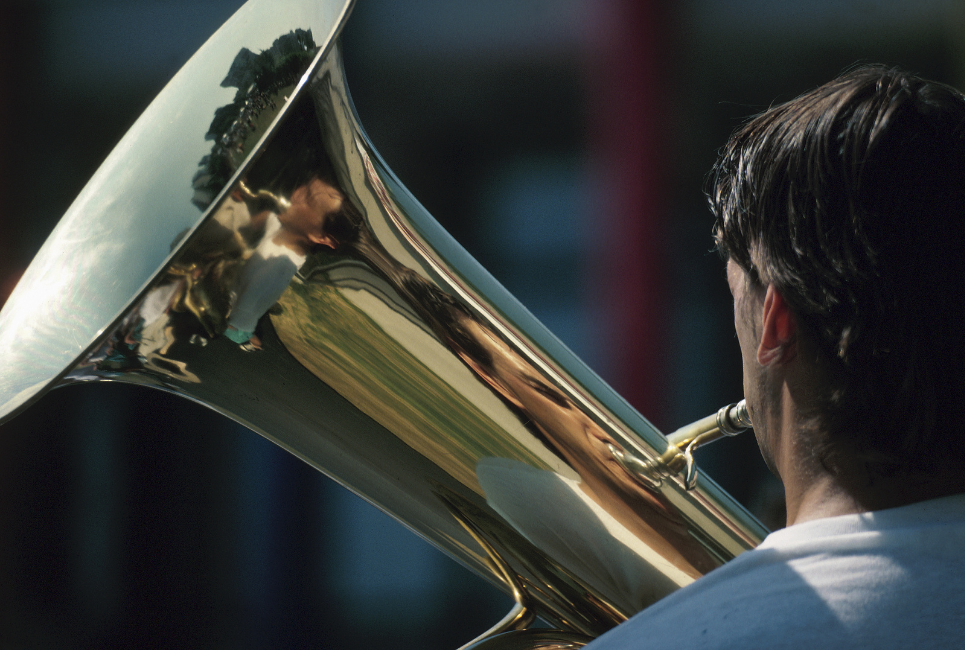- Top Trumpet Embouchure Techniques: Options for Beginners Through Professionals - October 12, 2022
- Is the Trumpet Hard to Learn? - September 30, 2022
- Best Leblanc Clarinet Models Guide: From Soprano to Contrabass - September 5, 2022
Have you been playing the tuba for a while? Do you want a quick and affordable way to upgrade your playing? Consider some of the best tuba mouthpieces picks to decide if you should get one.
While your current setup might be fine, it could also limit you as a musician. Fortunately, you don’t need to buy a whole new instrument to change your sound or get better. But you do need to know how to select the right mouthpiece for you.
Why A Tuba Mouthpiece Matters
Having a good tuba mouthpiece can make it much easier to play the instrument, either in the extremes or overall. If you struggle to play some of the higher notes, you might find a new mouthpiece is all you need. Since the mouthpiece is where you blow into the tuba, it can have a big effect on the sound. Even if you don’t have a hard time playing, a different mouthpiece might help change your tone color to make it brighter or darker.
Certain mouthpieces are also more comfortable to play with because of their size or shape. Think about the problems you have with your tuba playing to decide if you might be ready to go mouthpiece shopping.
How To Choose A Tuba Mouthpiece
After you realize that a new tuba mouthpiece might help improve your playing, it’s time to consider what you want. The best tuba mouthpiece picks for beginners are quite different from those of a professional. No matter where you are in your journey of learning the tuba, you need to know how to select the right equipment. That way, you’ll have the motivation and desire to keep learning and getting better.
Here are a few factors to think about and things to do to find the best tuba mouthpiece for you.
Shape
A lot of people probably think that all tuba mouthpieces are the same shape, and that’s not entirely wrong. However, there are some small differences in mouthpieces that can affect how they are to play. Each part of the mouthpiece can affect the shape and sound, including the:
- Rim
- Cup
- Throat
- Backbore
For example, a mouthpiece with a round, wide rim can be easier to play with, and it’s more comfortable. But a narrow rim can provide a more precise attack when playing notes. Shallow cups are easy to play with and reduce fatigue, but they have a brighter sound.

Size
While the sizes don’t vary significantly, they can affect your sound and ease of playing. A smaller mouthpiece is usually better for beginners and younger players.
The design helps you get a good embouchure and blow a good stream of air. But you don’t have to worry about filling up as much space with your air as you would if you used a bigger mouthpiece.
Even if you have experience playing the tuba, the size can affect the sound quality you get. A smaller mouthpiece helps offer a brighter sound, while you can sound darker on a bigger mouthpiece.
Material
The material can also be a crucial element in choosing between the best tuba mouthpiece picks. Silver and gold plating are both common, and they offer different benefits.
For example, gold sounds a bit warmer than silver, so you can use that to counteract the brightness of a smaller mouthpiece. Gold-plated mouthpieces are also great for anyone with a silver allergy.
However, gold does cost more than silver, so silver-plated mouthpieces are fantastic for someone on a budget. Just remember that silver can tarnish, including silver plating. So keep it clean and consider using an anti-tarnish strip to help protect it.
Manufacturer
You should also make sure to buy your tuba mouthpiece from a reputable maker, such as Bach or Yamaha. While you can find tons of cheaper, no-name mouthpieces online, they aren’t worth it.
They won’t have the same level of quality control as more reputable brands. Sure, the price difference may seem like a good deal, but it’s probably too good to be true.
If you don’t want to pay the full price on a tuba mouthpiece, look at the used market. You might be able to find a used model in good condition, and you can save quite a bit of money.
Price
The next thing to think about is how much a mouthpiece costs and how that relates to the value you get. More expensive gear isn’t always better, particularly if you’re still new to playing the tuba. Think about the features and sound you want as well as your budget. Make sure your budget is realistic because you can’t expect to get a good mouthpiece for $10.
As you advance, you should prepare to spend more on a mouthpiece. Some professional models cost around $100, give or take depending on the brand and features.
Get Recommendations
You can go online and find tons of available tuba mouthpieces, but not all of them are a good fit for you. If you want to narrow your search quickly, ask a teacher or another tuba player you know what they would recommend. When they know you and your playing, they can tell you about specific models that may help. Every player is different, and if the person knows your playing style, they can consider that.
Now, make sure the player doesn’t just recommend the mouthpiece they use. Even if they have a perfect sound, you might not sound that great either because of your playing level or even your tuba itself.
Test Multiple
Next, you should find at least two or three options to try. Some players luck out and love the first mouthpiece they play, and it works well for them for years. However, a lot of musicians aren’t that lucky. Give yourself time to test and compare a few models from different manufacturers and with different features and materials.
That will give you a chance to figure out which features you like and don’t like. Then, you can test other mouthpieces with the right features and design, so you can find the best option for you.
Focus On Ease
If you can’t decide if you like a certain mouthpiece better than another, think about which is the easiest to play. Test each mouthpiece throughout the entire range of notes and dynamics on your tuba.
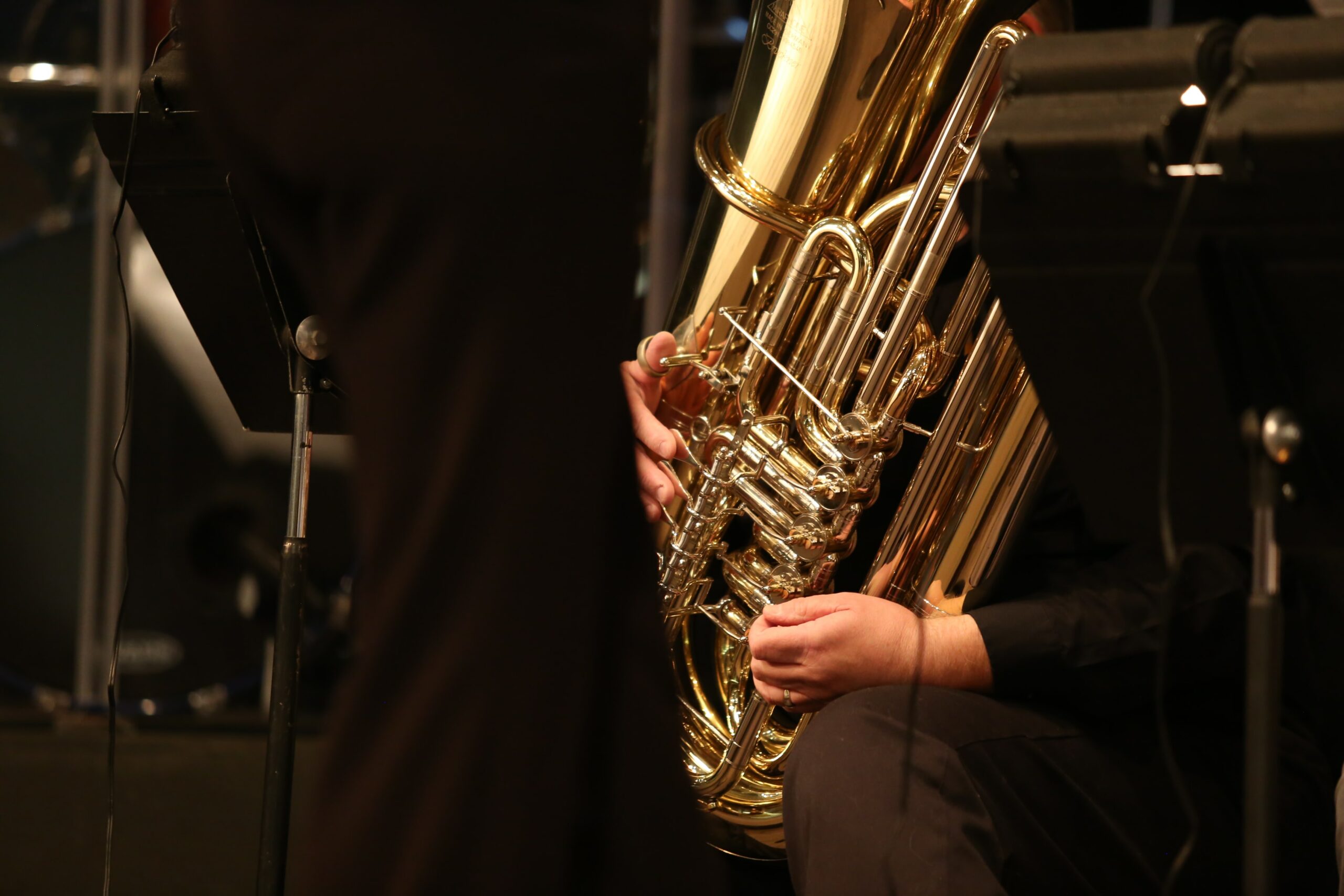
You might find that it is easier to play softly or for playing high notes. Ideally, one of the mouthpieces you try works well for all notes and volume levels.
And the mouthpiece you select shouldn’t force you to overblow or work too hard to get a sound. If you do have that problem move to a different mouthpiece and stop wasting your time. You may be able to break it in, but it’s not worth the risk.
Record And Listen
As you test different mouthpieces, record yourself so that you can listen back later. Not only will that give you a chance to take playing breaks during a trial, but you can hear each option in a new way. When you test a mouthpiece, you may need to focus on playing, so it can be hard to analyze the accessory itself. But if you listen back, you can focus on listening for any nuances or your overall sound quality.
Be sure you also record yourself playing on your current mouthpiece. Then, you can compare everything to decide if an upgrade is even worth it right now. Your current setup might be just as good, and you can wait to buy a new mouthpiece later.
Best Tuba Mouthpiece Picks
Now that you know what to look for and how to try some of the best mouthpiece picks, you need to know where to start. If you shop online, you can find tons of gear from cheap or no-name brands. And when you’re a beginner, it can be especially difficult to know which brands you can trust and which to avoid. Luckily, there are quite a few mouthpieces from trustworthy brands.
Here are some of the best tuba mouthpieces to try when you’re ready to upgrade.
Bach Tuba Mouthpiece 18
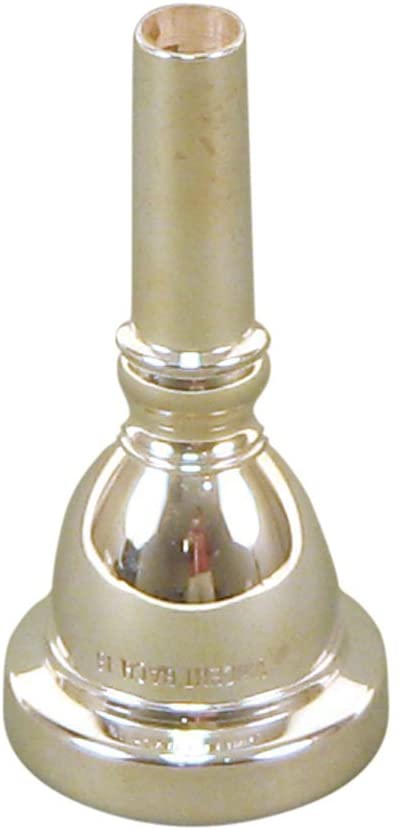
Bach makes some of the best brass instruments and accessories, and the Tuba Mouthpiece 18 is no exception. It features a medium-sized cup with a medium depth and a diameter measuring 32.10mm (millimeters). The rim is also medium-wide, so it’s a great option for different styles of playing. You can use this as a beginner or advanced player, and it will sound great.
This model has a fantastic tone and great staying power, so you can project across a big ensemble. It’s a silver-plated option, so it can offer a bright sound without being too bright.
Pros
- Fits different tubas
- Versatile
- Durable and heavy
Cons
- Not the best for high notes
Bach Tuba Mouthpiece K33518
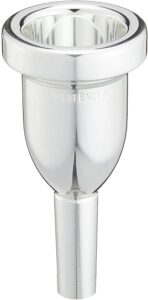
If you want something a little better than the model 18, look at the Bach Tuba Mouthpiece K33518. The mouthpiece has many of the same features, such as a medium-wide rim and a medium cup.
However, this model is the Megatone model, which means you can use it to play louder than other mouthpieces. And you don’t give up any control when you play at any dynamic.
Some players have no trouble with it throughout the tuba’s range, but others struggle to play up high. Still, this is a great option to try if you’re looking for a quick upgrade.
Pros
- Great sound
- Easy to play loud
- Can control it
Cons
- High register isn’t always easy
Conn-Selmer Tuba Mouthpiece 120S
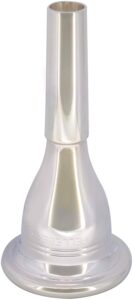
While Conn-Selmer is typically known for making woodwinds, their Tuba Mouthpiece 120S is an excellent choice. The model projects well, so you can use it in a full orchestra or band setting. It sounds very similar to an organ, so you can use it to replace the bass line of that instrument in a smaller group. This model has a brass base with silver plating, so it sounds similar to many other models.
You can play this mouthpiece in a concert setting on your tuba, and it works on the marching field when playing the sousaphone. Even though it’s not cheap, it’s a great value for the price.
Pros
- Great tone
- Easy to project
- Versatile
Cons
- Not the best for serious players
Conn Helleberg Tuba Mouthpiece Standard
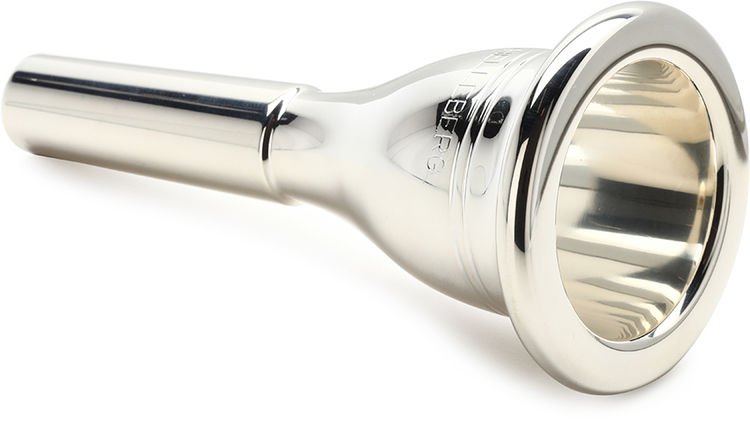
The Conn Helleberg Tuba Mouthpiece Standard is one of the best tuba mouthpiece picks, and there’s a reason so many people use it. Inspired by the famous tuba player August Helleberg, this mouthpiece offers a rich sound.
You can use it to play pedal tones, high notes, and everything in between. It’s a very versatile option, and players of all abilities should give it a try. This model is a standard size, so it’s not too big or too small for certain types of playing. If you want something to use every day, you can’t go wrong with the Helleberg mouthpiece.
Pros
- Versatile
- Great for many players
- Standard size
Cons
- The tone isn’t for everyone
Yamaha 67 Tuba Mouthpiece
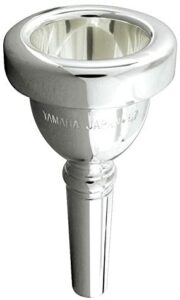
Yamaha is another fantastic musical instrument company, and the 67 Tuba Mouthpiece is a great model. It’s a bit larger than the average tuba mouthpiece, which can help darken the sound and support low notes. There’s a 31.92mm-diameter rim, and it has a semi-wide backbore. The standard cup keeps it from being too big, so it’s easy for a lot of people to play.
And the thicker layer of silver plating means it won’t chip off quickly, so you can use it for years. If you’re on a budget, this mouthpiece is worth trying to save money without losing out on quality.
Pros
- Good sound
- Durable
- Easy to play
Cons
- A bit big
Schilke Tuba Mouthpiece 69C4

The Schilke Tuba Mouthpiece 69C4 is fantastic for serious tubists and anyone with a bit more money to spend. It’s a silver-plated option that looks and sounds good both indoors and outdoors. That means you can use it in a concert band and when marching and playing the sousaphone. Pedal tones are especially easy to produce, so you can play the lower notes well.
It’s comfortable to use when playing, so you can keep your chops up longer. You can use it to get through a long rehearsal or concert and not worry about losing your sound.
Pros
- Durable
- Looks good
- Versatile
Cons
- Pretty expensive
FAQs About The Best Tuba Mouthpiece Picks
Answer: When looking at them from far away, tuba mouthpieces look like they’re the same size. But if you look closer, you may see a slight difference in the size of the rim, cup, and throat.
The difference isn’t too significant since it’s usually less than a centimeter between the biggest and smallest sizes. Still, the size can affect how you sound and how easy certain notes are to play.
Answer: If you need to play in a concert and marching band, you don’t need to buy a separate mouthpiece for your tuba and sousaphone. Just make sure that the mouthpiece fits and sounds good on both instruments before you buy it.
That way, you’ll be able to get a good sound in both scenarios. If the mouthpiece doesn’t work with one or the other, you can get a different one overall or get one mouthpiece for each instrument.
Answer: Playing the tuba can be difficult because the size makes it hard to hold, and you need a lot of air to make a sound. But getting the right mouthpiece may make it easier.
A good mouthpiece will help you form a good embouchure and get your air moving. That way, the air can travel through the entire length of the tuba.
Answer: It’s time to upgrade your tuba mouthpiece when you start to struggle when you didn’t use to have problems. Whether you can no longer produce high notes consistently or you can’t stay in tune, your mouthpiece might need an upgrade.
Sometimes, the tuba itself will be the problem, and it might need repairs or maintenance. But getting a new mouthpiece is an excellent way to change your setup without spending thousands on a new instrument.
Answer: You can get a new mouthpiece for plenty of reasons. In some cases, it’s necessary to improve your playing. However, you might find a different mouthpiece is better when playing certain notes or a specific style of music.
Final Note On The Best Tuba Mouthpiece Picks
The best tuba mouthpiece picks make it easier to play high and low notes, loud and soft. Whether you’re a beginner or professional, you should consider the Bach model 18 or the Yamaha 67. If those don’t work well with you or your tuba, check out the other models on this list. You never know which will be the best fit until you try them all.


